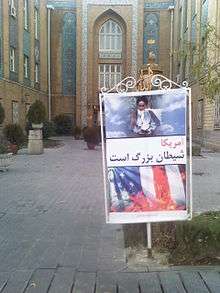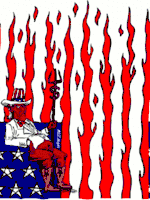Great Satan
The Great Satan (Persian: شيطان بزرگ; Shaytân-e Bozorg) is a demonizing epithet for the United States of America in Iranian foreign policy statements. Occasionally, these words have also been used toward the government of the United Kingdom.

 |
|---|
| This article is part of a series on the politics and government of Iran |
| Government of Islamic Republic of Iran |
|
Leadership |
|
Executive |
|
|
Supreme Councils |
|
Local governments
|
|
|
|
Outside government |
|
The term was used by Iranian leader Ruhollah Khomeini in his speech on November 5, 1979 to describe the United States, which he accused of imperialism and the sponsoring of corruption throughout the world.[1] The speech occurred one day after the onset of the Iran hostage crisis.
Ayatollah Khomeini also occasionally used the term "Iblis" (the primary devil in Islam) to refer to the United States and other Western countries.
Background
The post-revolutionary government of Iran has regarded the United States and the United Kingdom as imperialist states, who have a long history of interfering in Iran's internal affairs. In 1907, an Anglo-Russian agreement between Russia and Britain divided Iran into spheres of influence, ignoring, although not terminating, Iran's sovereignty. In 1953, during the Cold War, British intelligence officials[2] and the administration of the U.S. President Dwight D. Eisenhower planned a joint Anglo-American operation to overthrow the elected prime minister, Mohammad Mossadeq.[3][4][5] The Eisenhower administration was concerned that Mossadeq's nationalist aspirations could lead to an eventual communist takeover of Iran.[6][7][8][9][10][11] The operation was code-named Operation Ajax. At first, the military coup seemed to fail, and Shah Mohammed Reza Pahlavi fled the country.[12][13] After widespread rioting and with help from the CIA and British intelligence services, Mossadeq was defeated and the Shah returned to power, ensuring support for Western (chiefly British) oil interests and ending the perceived threat of communist expansion. General Fazlollah Zahedi, who led the military coup, became prime minister.
In 1965, Ayatollah Khomeini was exiled for criticizing the White Revolution's vote to women, land reform and the Shah's unpopular[14][15] Status of Forces Bill, which gave U.S. military personnel diplomatic immunity for crimes committed in Iran.[16] By the early 1970s, many Iranians opposed the Shah's government.[17] Khomeini eventually returned to Iran and led the 1979 Iranian revolution. During the Iranian Revolution, demonstrators commonly chanted slogans such as "Death to Shah," "Independence, Freedom, Islamic Republic,"[18] and "Death to America".[19]
Definition

Khomeini is quoted as saying on November 5, 1979, "[America is] the great Satan, the wounded snake."[20] The term was used extensively during and after the Islamic Revolution,[21] and it continues to be used in some Iranian political circles. Use of the term at rallies is often accompanied by shouts of "Marg bar Amrika!" ("Death to America"). It is used in academic journals.[22]
Lesser Satan
Khomeini called the Soviet Union, the principal antagonist of the US during the Cold War, the "Lesser Satan" because of its atheistic communist ideology, and he said that Iran should support neither side of the Cold War.[23]
The State of Israel was condemned as the "Little Satan" in 1979 by Khomeini when he was addressing Israel's backing of the Shah, its close ties to the US, and the ongoing Israeli–Palestinian conflict. Former Libyan leader Muammar Gaddafi also stated that "Israel is the little Satan" in a July 1980 interview.[24]
See also
- Iran–United States relations
- Devil (Islam)
- Anti-American sentiment
- Anti-Israeli sentiment
References and notes
- Khomeini, Ruhollah (5 November 1979). American plots against Iran (Speech). Iranian Central Insurance Office Staff. Imam's Sahifeh. Qum. Archived from the original on 22 May 2016. Retrieved 22 May 2016.
In this revolution, the Great Satan is America that gathers around other devils blatantly…If we see the US, this great Satan, raising chain and bringing the devils together around him, it is because the US grip over our country and our resources curtailed.
- Risen, James (16 April 2000). "SECRETS OF HISTORY: The C.I.A. in Iran -- A special report.; How a Plot Convulsed Iran in '53 (and in '79)". The New York Times. Retrieved 21 May 2016.
- Staff writer(s); no by-line. (c. 1975). "The Battle for Iran (excerpt)". Central Intelligence Agency. Retrieved 20 May 2016 – via Foreign Policy Magazine.
Complete secrecy about the operation that was known under the cryptonym of TPAJAX has been impossible to enforce...[T]he military coup that overthrew Mosadeq and his National Front cabinet was carried out under CIA direction as an act of U.S. foreign policy, conceived and approved at the highest levels of government.
- Wilber, Donald (March 1954). "CIA Clandestine Service History, "Overthrow of Premier Mossadeq of Iran, November 1952-August 1953," March 1954, by Dr. Donald Wilber" (PDF). Retrieved 20 May 2016.
In early summer of 1953 Carroll was assigned the task of planning military aspects of TPAJAX. Several assumptions first had to be taken into account: A. Operation would be joint operation with SIS.
- Wilber, Donald (March 1954). "CIA Clandestine Service History, "Overthrow of Premier Mossadeq of Iran, November 1952-August 1953," March 1954, by Dr. Donald Wilber" (PDF). p. iv. Retrieved 20 May 2016.
An estimate entitled "Factors Involved in the Overthrow of Mossadeq" was completed on 16 April 1953… In April it was determined that the CIA should conduct the envisioned operation jointly with the British Secret Intelligence Service (SIS). By the end of April, it was decided that CIA and SIS officers would draw up a plan… which would be submitted to CIA and SIS Headquarters, and to the Department of State and the Foreign Office for final approval.
- David M. Watry (10 December 2014). Diplomacy at the Brink: Eisenhower, Churchill, and Eden in the Cold War. LSU Press. p. 93. ISBN 978-0-8071-5719-0.
- Acheson, Dean (7 February 1952). "Telegram from The Secretary of State to the Embassy in Iran. (Memo of conversation 1 February 1952 between U.S. Department of State and British representatives regarding the Iranian political situation)". Office of the Historian of the United States Department of State. Retrieved 20 May 2016.
Although Mosadeq [will] not likely turn toward Russia it is highly improbable that he will do anything [to] check communism in Iran since his ideas of polit[ical] tolerance, neutrality, and fear of offending [the] USSR w[ou]ld prevent his taking action vs Tudeh regardless [of the] outcome [of] the oil question and request[s for] US financial assistance.
- Henderson, Loy (28 July 1952). "The Ambassador in Iran (Henderson) to the Department of State, repeated to London". Office of the Historian of the United States Department of State. Retrieved 20 May 2016.
…I could not but be discouraged at [the] thought that [a] person [Mosadeq] so lacking in stability and clearly dominated by emotions and prejudices sh[ou]ld represent [the] only bulwark left between Iran and communism… at one point I almost decided to abandon our conv[ersation] when he r[e]p[ea]t[e]d again and again in monotone that "Iran w[ou]ld never, never want UK and US to have any differences over it. Iran w[ou]ld prefer [to] go Communist than cause any trouble between US and UK."
- Henderson, Loy (28 July 1952). "The Ambassador in Iran (Henderson) to the Department of State, repeated to London". Office of the Historian of the United States Department of State. Retrieved 20 May 2016.
At this point Mosadeq began to chant that Iran w[ou]ld prefer to go communist than for US and UN [UK] to have differences of opinion with regard to it. Eventually I was able to tell him that US choice was not merely between US-UK friction and Iran going Communist. I stressed that if serious misunderstandings sh[ou]ld develop in present world situation between US and UK, Iran would go Communist anyway.
- Staff writer(s); no by-line. (28 July 1953). "FOREIGN RELATIONS OF THE UNITED STATES, 1952–1954. IRAN, 1951–1954: VOLUME X No. 339 Editorial Note regarding Department of State Bulletin 10 August 1953, page 178". Office of the Historian of the United States Department of State. Retrieved 20 May 2016.
Secretary Dulles held a press conference on July 28. In response to a reporter's question about the growing strength of the Tudeh Party in Iran, the Secretary replied as follows: "Recent developments in Iran, especially the growing activity of the illegal Communist party, which appears to be tolerated by the Iranian Government have caused us concern. These developments make it more difficult for the United States to give assistance to Iran so long as its government tolerates this sort of activity."
- Gleason, Sarell (17 September 1953). "No. 358 Memorandum of Discussion at the 160th Meeting of the National Security Council, Washington, August 27, 1953". Eisenhower Library, Eisenhower papers, Whitman file. Retrieved 20 May 2016 – via Office of the Historian of the United States Department of State.
Secretary [of State John Foster] Dulles commented that while what happened in Iran was spontaneous, he did feel obliged to say that a number of people in Iran had kept their heads and maintained their courage when the situation looked very tough… As a result of what had happened, Secretary Dulles informed the Council, the United States now had a "second chance" in Iran when all hope of avoiding a Communist Iran appeared to have vanished.
- Risen, James (16 April 2000). "Key Events in the 1953 Coup". The New York Times. Retrieved 21 May 2016.
Aug. 16, 1953…The shah flees to Baghdad.
- Berry, Burton Y. (17 August 1953). "Telegram No. 343 The Ambassador in Iraq (Berry) to the Department of State". Office of the Historian of the U.S. Department of State. Retrieved 21 May 2016.
On the third day Mosadeq by some means had been alerted and had had the time to take successful countermeasures so that when the Colonel arrived at Mosadeq's house he was himself arrested…This morning the Shah left his Caspian Palace in a Beechcraft with a pilot, one Palace official and his Queen and landed in Baghdad at 10:15. He said that he thought that he should not stay here more than a few days, but would then go to Europe and he hoped eventually to America. He added he would be looking for work shortly as he has a large family and very small means outside of Iran. I tried to boost his morale by saying that I hoped that soon he would return to reign over his people for whom he had done so much, but he replied that Mosadeq was absolutely mad and insanely jealous, like a tiger who springs upon any living thing that it sees moving above him. Shah believes Mosadeq thinks he can form a partnership with the [Communist] Tudeh Party and then outwit it, but in so doing Mosadeq will become the Dr. [Edvard] Bene[š] of Iran.
- Carsten Stahn; Jennifer S. Easterday; Jens Iverson (13 February 2014). Jus Post Bellum: Mapping the Normative Foundations. OUP Oxford. p. 468. ISBN 978-0-19-150938-4.
It is not uncommon for status questions to act as a lightning rod for…grievances of the local population…A vivid example is offered by Ayatollah Khomeini's speech of 26 October 1964 (Speech 16) denouncing the extension of diplomatic immunities to American military personnel in Iran.
- Hughes, Thomas L. (28 January 1965). "67. Memorandum From the Director of the Bureau of Intelligence and Research (Hughes) to Secretary of State Rusk; SUBJECT: The Significance of the Assassination of Prime Minister Hasan Ali Mansur". Johnson Library, National Security File, Robert W. Komer Files, Iran, 1965–March 1966. Retrieved 21 May 2016 – via Office of the Historian of the U.S. Secretary of State.
There is considerable discontent in Iran because of continued repression of opposition groups, exile of Ayatollah Khomeini, unpopular measures passed by the government such as the recent Status of Forces Bill, and the increase in the cost of basic fuels.
- Staff writer(s); no by-line. (2014). "Chronology: U.S.–Iran relations 1906-2002". PBS News\Frontline. Retrieved 21 May 2016.
1964... Khomeini is exiled to Turkey for his outspoken denunciation of the shah's Status of Forces bill, which grants U.S. military personnel diplomatic immunity for crimes committed on Iranian soil.
- Staff writer(s); no by-line. (May 1972). "Central Intelligence Agency\Directorate of Intelligence\Intelligence Report\Centers of Power in Iran". Source: Central Intelligence Agency, OCI Files, Job 79T00832A, Box 9, 46. Secret; No Foreign Dissem. Prepared in the Office of Current Intelligence and coordinated within CIA. Retrieved 21 May 2016 – via State Department Office of the Historian.
[P]laying an essentially negative role at present... are the clergy, whose strength lies in the emotions of the Iranian masses and whose opposition to the Shah's government is nearly total...Detailed information on the clergy is not available. There are perhaps 100,000 clergymen ranging from the mullah, the lowest clerical post, to the mojtahed.
- Staff writer(s); no by-line. (7 December 2009). "How Iran's opposition inverts old slogans". BBC. Archived from the original on 2 January 2010. Retrieved 21 May 2016.
One of the big anti-Shah chants ended with the slogan "Death to Shah!"...A main revolutionary cry was: "Estaghlal, Azadi, Jomhuriye Eslami" (Eng: Independence, Freedom, Islamic Republic).
- Staff writer(s); no by-line. (6 November 1979). "IRAN LEADERS BACK U.S. EMBASSY SEIZURE; Khomeini's Son Tells Students All American Ties Should Be Cut". The New York Times. Teheran. Reuters. pp. A1, A12.
Students Shout "Death to America!"…Tens of thousands of students surrounded the American Embassy compound today shouting anti-American slogans such as "Death to America!"...
- Christopher Buck, Religious myths and visions of America: how minority faiths redefined America's world role, page 136
- Iran & the Great Satan
- "America's foreign policy: Manifest Destiny or Great Satan?". Contemporary Politics.
- Katz, Mark N. (2010). "Iran and Russia". In Wright, Robin B. (ed.). The Iran Primer: Power, Politics, and U.S. Policy. United States Institute of Peace. p. 186. ISBN 978-1-60127-084-9.
- "This Week in History: Ayatollah Khomeini returns to Iran - Features - Jerusalem Post".
External links


- The Great Satan by Kavitha Rao, April 26, 2000
- 'Great Satan' warned of a burning hell by Ian Black, The Guardian, February 16, 2005
- How the "Great Satan" Became Just Great
